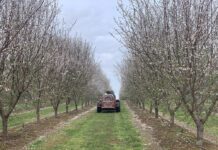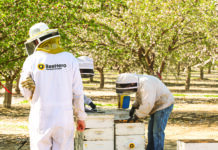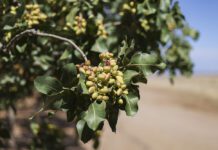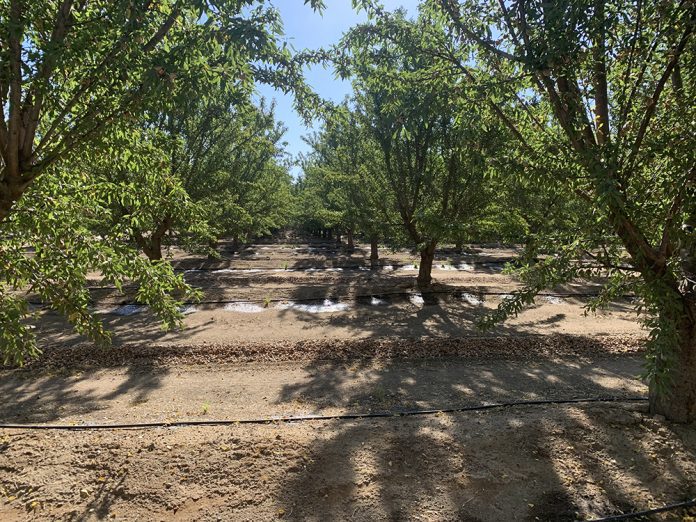
August means the start of harvest. This translates to long days if everything goes smoothly. The focus will be on current practices for a clean harvest with a quick look at the fall and next year.
Irrigation
As always, water comes first. The basic almond irrigation plan through July and into August is to limit water stress as much as possible up to preharvest irrigation cut off (apply 100% ET with target pressure chamber readings between baseline and -4 bars below baseline.) This could be called the “just enough plan.” Irrigating to refill the entire root zone with water each irrigation set could lead to slower, uneven dry down going into harvest and trunk damage (“barking”) in wetter areas across the orchard. On the other hand, final kernel size is less in trees with extended moderate to high water stress in the weeks before shaking compared to adequately watered trees. Protect the long-term health and productivity of the orchard (avoid/minimize shaker damage) and maintain nut size and income for this crop, and keep the trees adequately watered (no less than -4 bars below baseline).
Restart irrigation as soon as possible after shaking but don’t allow water to reach the nuts on the orchard floor. This minimizes water stress during harvest when buds for next year are starting to develop. Soon after shaking, sweeping and conditioning nuts into wide, thin windrows is becoming a common practice where growers can keep irrigation water off the windrows. In these windrows, nuts dry quickly yet some water can be applied. Once nuts are up, the goal is to return the trees to between -2 and -4 bars below baseline and keep that level through the fall.
Shaker Timing
When to shake? A whole article is needed for this topic (see links to articles at the end of column). However, here are some points to consider. Shaker damage shortens the life of an orchard. Bark naturally tightens over time from August into September. Wet trees can be delayed in maturity compared to dry trees in the same orchard and more vulnerable to shaker damage.
Consider shaking young orchards later in the harvest window and allowing a longer dry down time. Inshell nuts have been more valuable than meats in recent markets (but check with your processor for status in the current market.) Nuts with dry hulls (later shake) hull more easily than earlier harvested nuts but are more vulnerable to navel orangeworm (NOW) while drying on the tree.
Some varieties (e.g., Padre, Independence, Winters) are hard to shake cleanly and should be harvested when 100% hull split has occurred, but hulls are still green. Finally, someone with skin in the game and the authority to shut down the harvest should be on-site during shaking, especially early in harvest for a variety when trunk damage risk is highest.
Almond Pest and Disease
Major pests to consider this time of year are navel orangeworm (NOW) and ants. Talk with your PCA about ant populations in your orchard and materials, rates and timing if needed. For best results with all ant-baits, use only newly opened, fresh material to dry ground and don’t irrigate for 48 hours.
NOW pressure varies even within a district, so check with your PCA about trap catch timings and numbers in your orchard(s) so you can consider harvest timings based on estimates of NOW flight and egg laying. Cracking out early split (drier) nuts as harvest approaches helps get a handle on damage potential and harvest timing. A nut on the orchard floor is much safer from NOW than a sprayed nut in the tree.
A timely harvest any time after all nuts in the orchard are at 2c hull split stage (see picture) is an excellent, free tactic to limit damage. Nuts on the orchard floor are much harder for female moths to find and infest with their young (lay eggs). Preharvest interval for pesticides is based on shake date, not pickup, and most insecticides require at least 7 to 10 days between spraying and shaking. Exceptions include B.t. (Javelin®, Dipel®, etc.) and Danitol® with PHIs of zero and three days, respectively. Selecting insecticides that don’t flare mites can mean less leaf loss at shaking and so help shorten nut drying time on the orchard floor. Check out UC IPM information on pesticide impact on beneficials at link below.
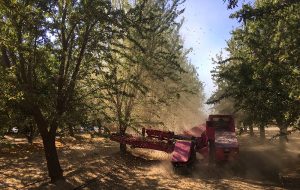
How a spray is applied makes a significant difference in NOW control, especially under higher NOW pressure. Sprayed using 2 MPH sprayer speed and high volume (200 GPA) sprays reduced NOW damage compared with 100 GPA. Spraying during cooler temperatures (<80 degrees F) and higher relative humidity (<40%) reduced spray droplet evaporation and increased spray coverage by 50% in the treetops, where there are more nuts.
August is a very dry month in California, so foliar disease issues should be generally low. However, El Nino conditions are expected to last through the fall, and that may mean a wet winter (depending on where you farm). Make a note to talk with your PCA after almond harvest regarding Phytophthora management after harvest.
Other Considerations
With a wet winter possibly on the way, this could be a good year to wait until January to prune young orchards. January pruning produced lower pruning wound disease infection rates compared to the fall and early winter (September through December) pruning timings in trials by a research team led by Dr. Flo Trouillas, UC Davis plant pathology extension specialist. Infection rates of 80% to 100% at all pruning timings were recorded when pruning occurred immediately before rain. Thiophanate-methyl (Topsin-M®, etc.) spray immediately after pruning consistently delivered the lowest infection rates in all UC trials in almond.
Speaking of chances for a wet winter and steps to help manage intense rainfall, state funding is available through CDFA’s Healthy Soils Program (see link at the end of this column) to help growers with costs of organic matter mulches (compost, shells, etc.) and/or cover crops. These practices can help soil health and reduce soil erosion/improve infiltration of rainwater into and through orchard soils. Some practices (legume cover crops, almond shell, etc.) can deliver significant amounts of essential nutrients. Applications close August 25.
Sample dry hulls from windrows of different varieties, keep the samples separate and send to the lab for boron analysis. A fall B spray can increase yield of well managed almonds by 100 to 200 kernel pounds per acre if hull B levels are below optimum. If hull B levels are 100 ppm or lower, talk with your CCA about B fertilizer programs for next spring. In my experience, where needed, B fertilization delivers the best return on investment ($ back for $ spent) of all nutrients. However, fall applied soil B fertilizer won’t get into flowers in time to help improve nut set next spring. Note: Hull B levels at or above 300 ppm indicate toxic levels of B in the orchard.
August is when the last 25% of the annual nitrogen budget should be applied to bearing walnuts.
This is also the month to start managing fall and early winter freeze risk. Young trees should get no nitrogen after August while the N cutoff for mature trees is September (no postharvest N, period). In early to mid-September, temporarily shut off irrigation to stop shoot growth and set a terminal bud in young, non-bearing walnuts. Once the buds are set, return to regular irrigation timed by tree or soil monitoring. Bearing trees may set a terminal bud when irrigation is shut off for harvest dry down. Critical point: start irrigation again once the terminal bud is set (or harvest is complete). For freeze management practices later in the fall plus pictures and more detail, see the referenced link.
Looking Ahead
The objective almond crop estimate came in at 2.6 billion pounds, which would mean the lowest yield/acre since 2008 without (probably?) much chance of major price relief. With good water availability this year and generally more healthy orchards, chances are better for a big crop state-wide in 2024. While the future is unknown (bloom weather?), this possible scenario means growers could face continued low nut prices. Here are a couple of planning points to ponder.
Good to high yields will be needed to maintain income if 2024 is another low-price year, yet low prices for several years have already forced input cutbacks. One source of partial relief could be alternative sources of nutrients, particularly big-ticket items such as nitrogen and potassium. These inputs could help reduce fertilizer rates and overall costs while delivering essential nutrients (see referenced links on alt nutrient sources.) California can help with costs of these practices through the Healthy Soils program.
Many growers have been practicing IPM for many years. This approach to pest management helps manage certain pest pressures, with reduced input in many cases, which is important during times of low prices and high input costs. While I realize that IPM doesn’t solve all pest problems, this approach can help limit damage from many damaging pests such as spider mites and Phytophthora. A knowledgeable PCA can help with IPM practices and help growers find the best ROI for what inputs can be made. The UC IPM ag web site (ipm.ucanr.edu/agriculture/) is a great resource.
Continued “small ball” may be the path to staying in business in the short term. Alternative nutrient sources and focus on IPM could be part of the future of successful almond growing.
Wishing all growers and their advisors a safe and successful harvest.
References
Irrigation
sacvalleyorchards.com/manuals/stem-water-potential/advanced-swp-interpretation-in-almond/
anrcatalog.ucanr.edu/pdf/8503.pdf
When to shake almond trees
thealmonddoctor.com/shaking-almond-trees-when-to-start/
sacvalleyorchards.com/blog/almonds-blog/when-do-you-shake/
Stockpiling Best Management Practices
sacvalleyorchards.com/almonds/horticulture/stockpiling/
Ant management
ipm.ucanr.edu/agriculture/almond/ants/
Pesticide impact on beneficial insects and mites
ipm.ucanr.edu/agriculture/almond/
CDFA’s Healthy Soils Program
https://www.cdfa.ca.gov/oefi/healthysoils/
Alternative sources of nutrients
sacvalleyorchards.com/blog/almonds-blog/applying-amendments
sacvalleyorchards.com/blog/common-concerns/alternative-nutrient-sources/
Walnut fall freeze protection
sacvalleyorchards.com/walnuts/horticulture-walnuts/prepare-for-next-sudden-autumn-freeze/


